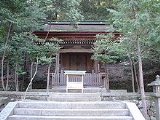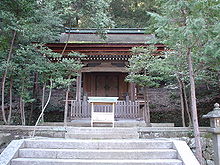
Tsuki-Yomi
Encyclopedia

Shinto
or Shintoism, also kami-no-michi, is the indigenous spirituality of Japan and the Japanese people. It is a set of practices, to be carried out diligently, to establish a connection between present day Japan and its ancient past. Shinto practices were first recorded and codified in the written...
and Japanese mythology
Japanese mythology
Japanese mythology is a system of beliefs that embraces Shinto and Buddhist traditions as well as agriculturally based folk religion. The Shinto pantheon comprises innumerable kami...
. The name Tsukuyomi-no-Mikoto is a combination of the Japanese words for "moon; month" (tsuki) and "to read; to count" (yomu). Another interpretation is that his name is a combination of "moonlit night" (Tsukiyo) and a verb meaning "to look at" (miru). Yet another interpretation is that the kanji
Kanji
Kanji are the adopted logographic Chinese characters hanzi that are used in the modern Japanese writing system along with hiragana , katakana , Indo Arabic numerals, and the occasional use of the Latin alphabet...
for "bow" (弓, yumi) was corrupted with the kanji for "yomi". "Yomi
Yomi
, the Japanese word for the underworld in which horrible creatures guard the exits; according to Shinto mythology as related in Kojiki, this is where the dead go to dwell and apparently rot indefinitely. Once one has eaten at the hearth of Yomi it is impossible to return to the land of the living...
" also may refer to the Japanese underworld, though this interpretation is unlikely.
Tsukuyomi-no-Mikoto was the second of the "three noble children" born when Izanagi-no-Mikoto
Izanagi
is a deity born of the seven divine generations in Japanese mythology and Shinto, and is also referred to in the roughly translated Kojiki as "male-who-invites" or Izanagi-no-mikoto. It is also pronounced Izanaki-no-Okami....
, the god who created the first land, Onogoro-shima, was cleansing himself of his sins while bathing himself after escaping the underworld
Underworld
The Underworld is a region which is thought to be under the surface of the earth in some religions and in mythologies. It could be a place where the souls of the recently departed go, and in some traditions it is identified with Hell or the realm of death...
and the clutches of his enraged dead wife, Izanami-no-Mikoto. Tsukuyomi-no-Mikoto was born when he washed out of Izanagi-no-Mikoto's right eye. However, in an alternate story, Tsukuyomi-no-Mikoto was born from a mirror made of white copper in Izanagi-no-Mikoto's right hand.
After climbing a celestial ladder
Ladder
A ladder is a vertical or inclined set of rungs or steps. There are two types: rigid ladders that can be leaned against a vertical surface such as a wall, and rope ladders that are hung from the top. The vertical members of a rigid ladder are called stringers or stiles . Rigid ladders are usually...
, Tsukuyomi-no-Mikoto lived in the heavens, also known as Takamagahara, with his sister Amaterasu Omikami
Amaterasu Omikami
, or is apart of the Japanese myth cycle and also a major deity of the Shinto religion. She is the goddess of the sun, but also of the universe. the name Amaterasu derived from Amateru meaning "shining in heaven." The meaning of her whole name, Amaterasu-ōmikami, is "the great August kami who...
, the sun goddess.
Tsukuyomi-no-Mikoto angered Amaterasu Omikami when he killed Uke Mochi
Uke Mochi
is a goddess of food in the Shinto religion of Japan. When Uke Mochi was visited by Tsukuyomi she prepared a feast by facing the ocean and spitting out a fish, then she faced the forest and bountiful game spewed out of her anus, finally turning to a rice paddy she coughed up a bowl of rice....
, the goddess of food. Amaterasu Omikami once sent Tsukuyomi-no-Mikoto to represent her at a feast presented by Uke Mochi. The goddess made the food by turning to the ocean and spitting out a fish, then facing the forest and game came out of her mouth, and finally turned to a rice paddy and coughed up a bowl of rice. Tsukuyomi-no-Mikoto was utterly disgusted by the fact that, although it looked exquisite, the meal was made in a disgusting manner, and so he killed her.
Soon, Amaterasu Omikami learned what happened and she was so angry that she refused to ever look at Tsukuyomi-no-Mikoto again, forever moving to another part of the sky. This is the reason that day and night are never together. In later versions of this myth, Uke Mochi is killed by Susanoo-no-Mikoto.

